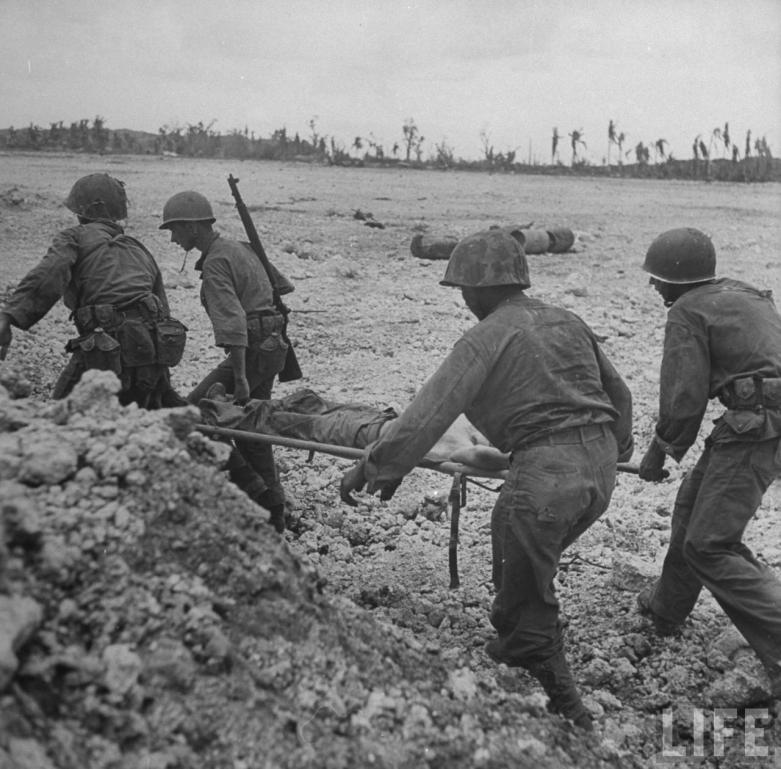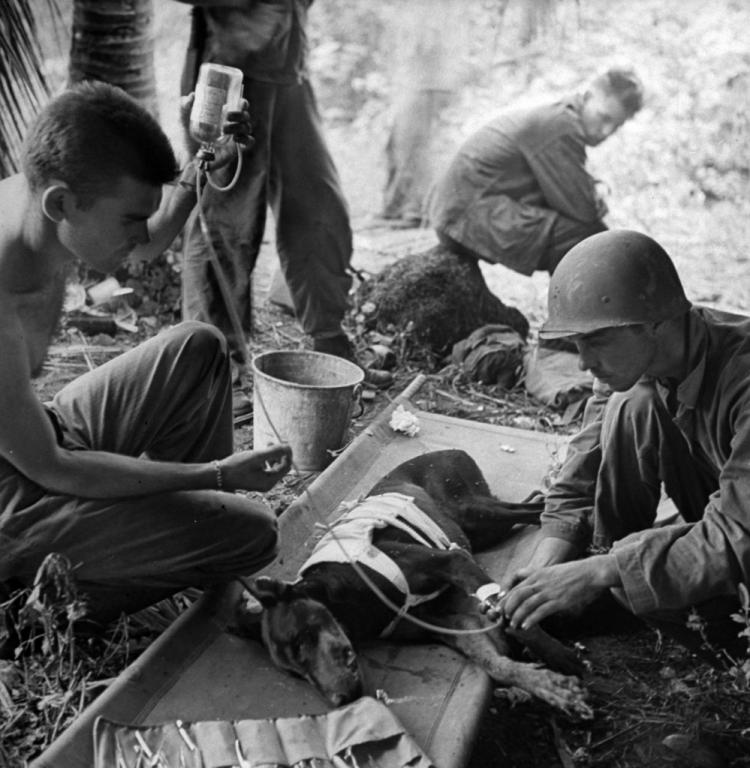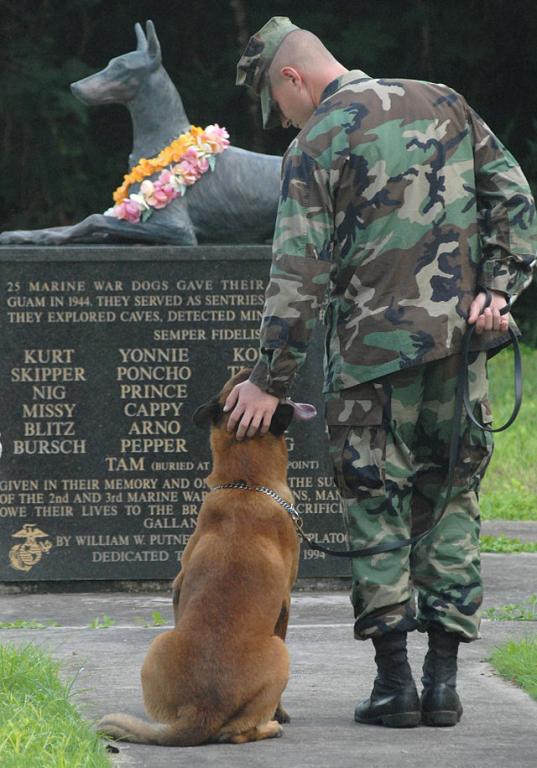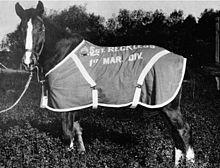-
Contributing Member


15-047 Garand Picture of the Day - Orote Pennisula.

American soldiers carrying casualty on stretcher during WWII action on Orote Pennisula.
Location:Guam
Date taken:1944
Photographer:W. Eugene Smith
Information
 |
Warning: This is a relatively older thread
This discussion is older than 360 days. Some information contained in it may no longer be current. |
|
He is no fool who gives what he cannot keep to gain that which he cannot lose
There are no great men, only great challenges that ordinary men are forced by circumstances to meet.
-
The Following 11 Members Say Thank You to Mark in Rochester For This Useful Post:
25-5,
30-06_mike,
A. F Medic,
bearrowland,
Bill Hollinger,
Bob Womack,
daboone,
frankderrico,
HOOKED ON HISTORY,
maxim,
sjc
-
02-16-2015 12:21 PM
# ADS
Friends and Sponsors

-
FREE MEMBER
NO Posting or PM's Allowed

Wounded combat dog during action on the Orote Peninsula, 1944

In the late summer of 1942, the Marine Corps decided to experiment with the use of dogs in war, which may have been a new departure for the Corps, but not a new idea in warfare. Since ancient times, dogs have served fighting men in various ways. The Romans, for instance, used heavy mastiffs with armored collars to attack the legs of their enemies, thus forcing them to lower their shields. On Guam, First Lieutenant William R. Putney commanded the 1st Dog Platoon and was the veterinarian for all war dogs on Guam. First Lieutenant William T. Taylor commanded the 2d Platoon. Both landed on the Asan-Adelup beach on Guam, while the 1st Platoon under Gunnery Sergeant L. C. Christmore landed with the 1st Provisional Brigade at Agat.
Man and dog searched out the enemy, awaited his coming, and caught him by surprise around the Marine perimeter or while on patrol. In addition, they found snipers, routed stragglers, searched out caves and pillboxes, ran messages, and protected the Marines’ foxholes as they would private homes. The dogs ate, slept, walked, and otherwise lived with their masters. The presence of dogs on the line could promise the Marines there a night’s sleep, for they alerted their handlers when the enemy came near. Overall, some 350 war dogs served in the Guam operation.
Early on in the Guam operations, some dogs were wounded or killed by machine gun and rifle fire, and incoming mortars were as devastating to the dogs as they were to the Marines. When the dogs were wounded, the Marines made a point of getting them to the rear, to the veterinarian, as quickly as possible. In the liberation of Guam, 20 dogs were wounded and 25 killed.
From the end of the campaign to the end of the war in the Pacific, Guam served as a staging area for war dogs, of which 465 served in combat operations. Of the Marine Corps war dogs, 85 percent were Doberman Pinschers, and the rest mainly German Shepherds. At the end of the Pacific War, the Marine Corps had 510 war dogs.
Shepherds. At the end of the Pacific War, the Marine Corps had 510 war dogs.
(Photo taken by W. Eugene Smith, The Time LIFE Archiv
-
Contributing Member


 [COLOR="black"]
[COLOR="black"]
---------- Post added at 12:10 PM ---------- Previous post was at 12:08 PM ----------
The War Dog Platoons
Marine Dogs of World War II
Converted for the Web from "Always Faithful: A Memoir of the Marine Dogs of WWII" by William W. Putney
http://www.worldwar2history.info/Marines/dogs.html
He is no fool who gives what he cannot keep to gain that which he cannot lose
There are no great men, only great challenges that ordinary men are forced by circumstances to meet.
-
The Following 7 Members Say Thank You to Mark in Rochester For This Useful Post:
-
FREE MEMBER
NO Posting or PM's Allowed

Best dog dog they ever had was not a dog

Sergeant Reckless, a horse that held official rank in the United States military,[1] was a mare of Mongolian horse breeding. Out of a race horse dam, she was purchased in October 1952 for $250 from a Korean stableboy at the Seoul racetrack who needed money to buy an artificial leg for his sister. Reckless was bought by members of the United States Marine Corps and trained to be a pack horse for the Recoilless Rifle Platoon, Anti-Tank Company, 5th Marine Regiment, 1st Marine Division.[1] She quickly became a unit mascot and was allowed to roam freely through camp, entering the marines' tents, where she would sleep on cold nights, and was known for her willingness to eat nearly anything, including scrambled eggs, beer, coca-cola and, once, about $30 worth of poker chips.
military,[1] was a mare of Mongolian horse breeding. Out of a race horse dam, she was purchased in October 1952 for $250 from a Korean stableboy at the Seoul racetrack who needed money to buy an artificial leg for his sister. Reckless was bought by members of the United States Marine Corps and trained to be a pack horse for the Recoilless Rifle Platoon, Anti-Tank Company, 5th Marine Regiment, 1st Marine Division.[1] She quickly became a unit mascot and was allowed to roam freely through camp, entering the marines' tents, where she would sleep on cold nights, and was known for her willingness to eat nearly anything, including scrambled eggs, beer, coca-cola and, once, about $30 worth of poker chips.
She served in numerous combat actions during the Korean War, carrying supplies and ammunition, and was also used to evacuate wounded. Learning each supply route after only a couple of trips, she often traveled to deliver supplies to the troops on her own, without benefit of a handler. The highlight of her nine-month military career came in late March 1953 during fighting around Vegas Hill when, in a single day, she made 51 solo trips to resupply multiple front line units.[2] She was wounded in combat twice, given the battlefield rank of corporal in 1953, and then a battlefield promotion to sergeant in 1954, several months after the war ended. She also became the first horse in the Marine Corps known to have participated in an amphibious landing, and following the war was awarded two Purple Hearts, a Marine Corps Good Conduct Medal and several other military honors.
Her wartime service record was featured in The Saturday Evening Post, and LIFE magazine recognized her as one of America's 100 all-time heroes. She was retired and brought to the United States after the war, where she made appearances on television and participated in the United States Marine Corps birthday ball. She was officially promoted to staff sergeant in 1959 by the Commandant of the Marine Corps.[3] She gave birth to four foals in America and died in May 1968. A plaque and photo were dedicated in her honor at the Marine Corps Base Camp Pendleton stables and a statue of her was dedicated on July 26, 2013 at the National Museum of the Marine Corps in Quantico, Virginia.
-
Contributing Member


He is no fool who gives what he cannot keep to gain that which he cannot lose
There are no great men, only great challenges that ordinary men are forced by circumstances to meet.
-
Thank You to Mark in Rochester For This Useful Post:

















 PM
PM








 [COLOR="black"]
[COLOR="black"]

